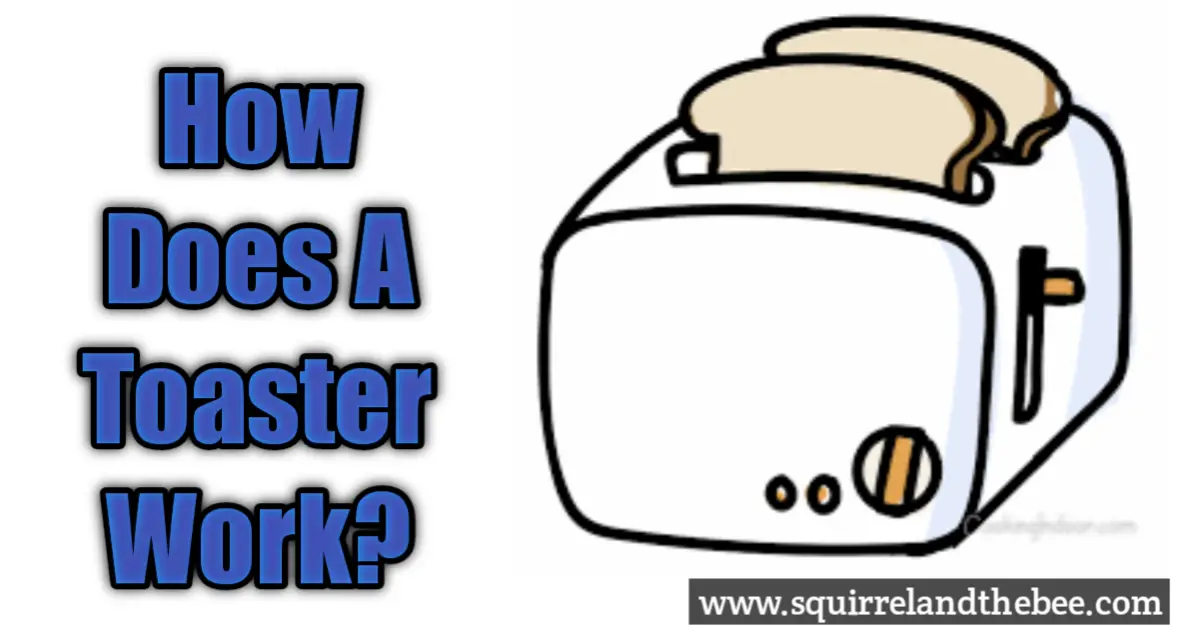Toasters are common in kitchens all over the world. How Does A Toaster Work? They are such a brilliant alternative to toasting using the oven, which can be both time-consuming and energy inefficient.
Getting a slice or two of toasted bread requires minimal effort. You just have to put the bread into the appliance, twist some knobs, and/or push some buttons, and then send the bread into the belly of the toaster, waiting for it to pop up again.
It all sounds very simple, doesn’t it?
But actually, the workings of a toaster are quite complex. So, if you’ve ever wondered how a toaster really works, the type of energy a toaster uses, and what happens in terms of heat transfer, this little guide has some answers for you.
A. CREATING THERMAL ENERGY WITH ELECTRICITY
- A WARNING
Next time you are toasting some bread, have a quick peek inside the toaster once it is turned on. You’ll notice an intense orange – that orange is metal glowing.
The glowing metal within the toaster has an electric current running through it. As the electric current passes through, it very quickly heats the metal, and that heat, in turn, is what toasts your bread.
This may shock you (pun intended), but that glowing metal can kill you. Please make sure you never touch the inside of a toaster when it is turned on, either directly or with another object (especially one that conducts electricity). If you do that, you will get an electric shock, and we aren’t talking about the little static shock you get from some items. You will die instantly.
If you do get something stuck within the toaster, be sure that the toaster is unplugged before trying to retrieve it.
2. THE PROCESS
The glowing metal we just told you about is commonly known as ‘elements’ or ‘filaments’. For the rest of this article, we will refer to these string-like wires as ‘filaments’.
Now we will get a bit scientific, but we will simplify it as much as possible.
Thermal energy inside a toaster occurs as follows:
- Electrical energy flows across the filaments from one side to the other.
- Electric energy is sent through the wires by electrons. Electrons are found within the atoms that make the filaments.
- The electrons within the filamentscrash into each other. This crashing of electrons creates heat.
- The heat generated by the crashing of electrons toasts your bread.
- When there is more electrical current passing through a thinner filament, more thermal energy is produced. This extra energy in thinner filaments is because there are more electron crashes, the more current passes through.
B. HOW THE TOASTER TOASTS
- The toaster is plugged into a socket. This connects it to an electrical supply when the socket is switched on.
- Electric current is able to run into the toaster. The current running into the toaster runs through the toaster filaments. These filaments are very thin but are spread wide across the interior of the toaster so that a whole slice of bread can be toasted. Filaments are on both sides of each toasting slot so that both sides of the bread are toasted simultaneously.
- Because the filaments are so thin, they will immediately glow once an electric current runs across them. In other words, they are almost instantaneously heating and ready to toast the bread.
- The heat from the filaments is emitted constantly until the electric current is turned off. Therefore, the toaster has to know when to turn the electric current off to avoid burning the bread.
C. HOW A TOASTER KNOWS TO TURN OFF
THERMOSTAT
1. WHAT IS A THERMOSTAT?
A thermostat is a device that is used to turn off an electric circuit or maintain temperatures. In a toaster, they are used to cut the electricity so that the filaments stop heating up. Your heating during winter may use a thermostat to keep your home at a constant temperature.
2. HOW DOES A TOASTER THERMOSTAT WORK?
Toasters use a bimetal strip thermostat. This thermostat is located close to the heating filaments. As the filaments heat and your bread toasts, the thermostat’s bimetal strip is also heating up.
The hotter the thermostat gets, the more the bimetal strip expands. As the bimetal strip expands, it begins to arc.
The temperature controls (the temperature settings are indicated differently depending on your brand of toaster) tell the thermostat how hot it needs to get before turning the electric current off. Essentially, when you set the temperature, you indicate to the thermostat how much the bimetal strip can bend before cutting the current.Once the bimetal strip has bent far enough, it will switch off the heating process.
3. TIMER
A timer is less complex than a thermostat.
With this form of control, you tell the toaster how long the filaments should remain being heated. Once that set time is over, the electric current heating the filaments will be turned off.
D. WHY DOES THE TOAST POP UP?
As well as the thermostat or timer cutting the electric current to the heated filaments, they also release a spring at the same time.
This spring is connected to the mechanism holding the toast or that the toast is resting on. When the spring is released, this mechanism pops up.
Why is this system in place?
Reason 1: Convenience
It is easier to remove toast from the toaster if some of the toast is protruding out of the toaster.
Reason 2: Safety
The heat within the toaster is still far too hot to be safe. Therefore, with the toast popped up, you can avoid the heat.
Furthermore, with the toast popped up, you are less likely to accidentally touch the filaments, which will at the very least burn you, and, in the worst-case scenario, give you enough of an electric shock to kill you.
Don’t forget, even if the toaster has stopped supplying current to heat the filaments, it is still plugged in. Any defect within the toaster that you are unaware of could cause an issue that leads to a fatal electric shock.




